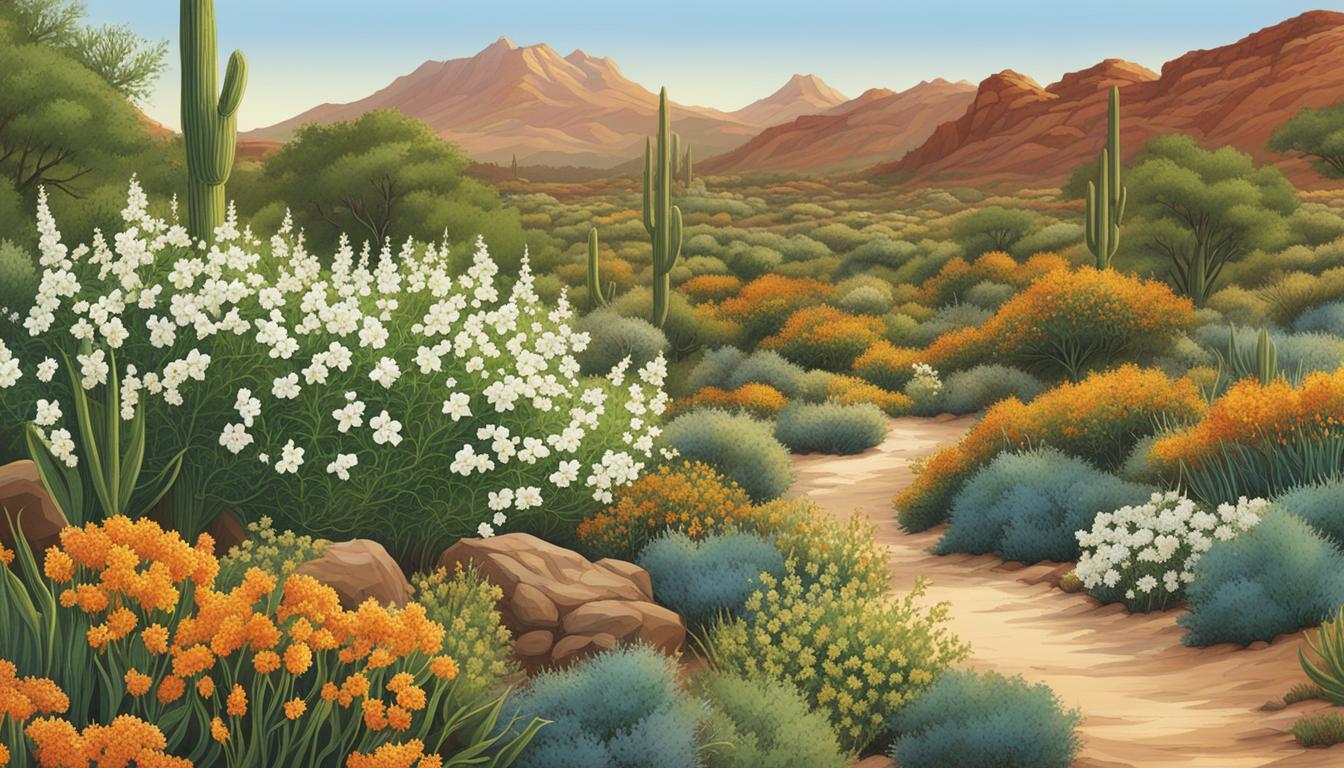Welcome to the fascinating world of chaparral – a versatile plant with a multitude of uses and benefits. Whether you’re interested in exploring its medicinal properties, incorporating it into your herbal remedies, or experiencing the health benefits it offers, chaparral has something to offer for everyone.
Known for its anti-inflammatory, antimicrobial, and anti-cancer properties, chaparral has been used for centuries to address various health conditions. From sexually transmitted diseases and infections to pain relief and cold-fighting properties, chaparral’s medicinal properties are truly remarkable. It is also recognized for its effectiveness in supporting overall health and well-being.
At Chaparral Products, we harness the power of chaparral and combine it with other natural ingredients like sarsaparilla, black seed, burdock root, bladderwrack, and sea kelp. Our organic herbal remedies, inspired by the renowned herbalist Dr. Sebi, are carefully crafted to provide you with a potent blend that supports your body’s natural healing processes.
Discover the wonders of chaparral and experience the numerous benefits it has to offer. Whether you prefer chaparral extract, chaparral supplements, or other chaparral-based products, you can trust in the power of nature to unlock its secrets for your well-being.
The Unique Characteristics of the Chaparral Biome
The chaparral biome is a captivating and diverse ecosystem that can be found in parts of California, Oregon, South Africa, and Australia. It is characterized by a unique blend of forests and grasslands, creating a visually stunning landscape.
The climate of the chaparral is marked by hot and dry summers, with temperatures reaching up to 100°F and minimal rainfall. This arid climate poses challenges for the plant and animal life that inhabit the biome, but they have developed fascinating adaptations to thrive in these conditions.
The flora of the chaparral biome consists of a variety of chaparral plants and animals that have evolved to withstand the arid conditions. These plants have developed deep root systems and waxy leaves to minimize water loss and maximize their ability to survive with limited water resources. Common plants found in the chaparral biome include manzanita, chamise, and sagebrush.
| Chaparral Plants | Chaparral Animals |
|---|---|
| Manzanita | Coyote |
| Chamise | Lizard |
| Sagebrush | Rabbit |
One of the notable features of the chaparral biome is its relationship with wildfires. While these fires may seem destructive, they actually play a vital role in the growth and regeneration of the ecosystem. The flora of the chaparral has developed fire-resistant burls, which allow them to regenerate quickly after a fire. This adaptation ensures the survival and continuation of chaparral plants and animals.
The chaparral biome is home to a wide variety of unique plant and animal species that have adapted to thrive in this challenging environment. It is a vibrant ecosystem that showcases the resilience and ingenuity of nature.
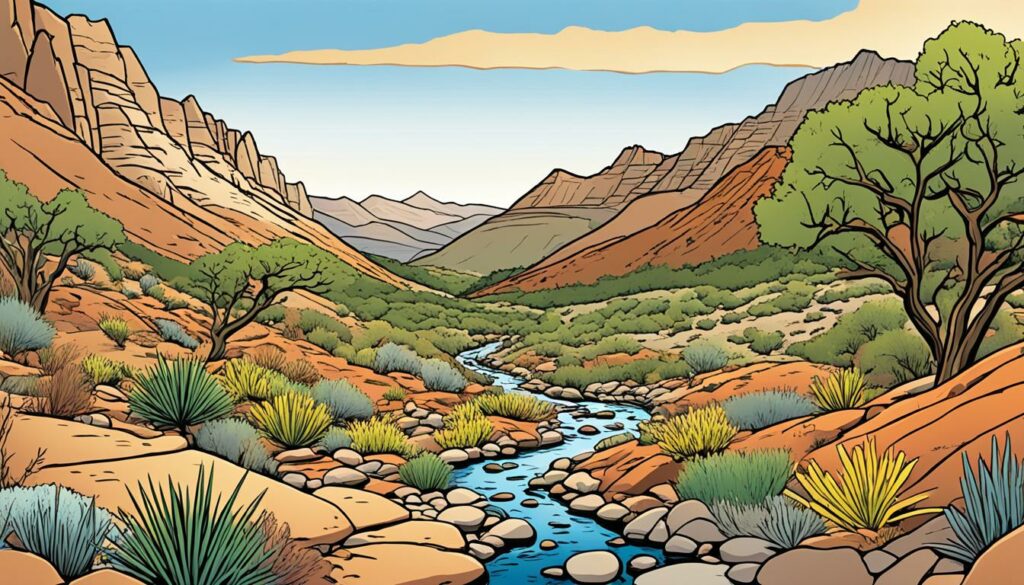
The Cultural Connections of the Chaparral Biome
The chaparral biome is not only a fascinating ecosystem but also holds significant cultural connections and historical tales. One such connection is the iconic cowboy chaps, protective leather leg coverings that were named after the chaparral biome itself. These chaps were designed specifically for cowboys to navigate the rugged terrain of the chaparral, highlighting the deep cultural roots and practicalities associated with this unique biome.
Another intriguing cultural connection in the chaparral biome is the presence of the California Grizzly Bear. Once thriving in this habitat, the California Grizzly Bear symbolized the wild spirit and resilience of the chaparral. However, sadly, the last sighting of this apex predator was in 1924, emphasizing the changing dynamics of ecosystems and the importance of biodiversity conservation. The disappearance of the California Grizzly Bear serves as a poignant reminder of the fragile balance between human activities and the preservation of wildlife.
The chaparral biome not only shapes cultural practices but also showcases the fragile beauty of wildlife in the face of evolving environments. It serves as a testament to the intricate connections between nature and culture and underscores the significance of preserving biodiversity for future generations.

The Birth of the Chaparral Biome
The chaparral biome, with its captivating beauty and diverse flora and fauna, has an intriguing origin story. It came into existence through a fascinating merger of cool ocean currents and high-temperature coastal landmasses, creating a unique and thriving ecosystem. The perfect combination of these elements provides the ideal conditions for chaparral vegetation to flourish.
This biome is characterized by the delicate balance between the cool ocean waters and the fiery earth. It is a symphony of life where greenery flourishes against the backdrop of cerulean waves. The birth of the chaparral biome showcases the remarkable power of nature to adapt and thrive in challenging environments.
To illustrate this beautiful merger of land and sea, take a moment to visualize the image below:

Comparison of Chaparral Biome Characteristics
| Characteristics | Chaparral Biome | Other Ecosystems |
|---|---|---|
| Climate | Hot and dry summers, minimal rainfall | Varies depending on the ecosystem |
| Flora | Diverse chaparral plants adapted to arid conditions | Dependent on the specific ecosystem |
| Fauna | Unique animal species with adaptations for survival | Varies according to the ecosystem |
As seen in the table above, the chaparral biome stands out for its distinct characteristics compared to other ecosystems. This uniqueness is a testament to the fascinating birth of the chaparral biome and the collaboration between land and sea.
The Weather Conditions in the Chaparral Biome
The distinctive weather conditions of the chaparral biome contribute to its unique ecosystem and pose challenges for both plant and animal life. During the summer season, the chaparral experiences intense dryness and aridity, creating an arid climate. Summers in the chaparral can be scorching, with temperatures soaring to an average of 100°F. This arid climate persists for up to five months, making it a harsh environment for flora and fauna.
Despite the harsh weather conditions, the plants and animals of the chaparral have evolved remarkable adaptations to survive in this arid climate. They have developed various strategies to conserve water and withstand extreme temperatures. These adaptations enable them to endure and thrive in a habitat that may seem inhospitable to others.
Adaptations of Chaparral Flora
The plant life in the chaparral biome has adapted to the arid climate in several ways. For example, many chaparral plants have small, waxy leaves that help reduce water loss through evaporation. They also have deep root systems that enable them to access water stored deep within the soil. Some plants exhibit dormancy during the dry season, conserving energy until favorable conditions return.
Furthermore, the chaparral is characterized by a unique resistance to wildfires. Many plants in this biome have thick bark, which protects them from heat damage during fires. Additionally, some chaparral plants have burls, specialized growths that allow them to quickly regenerate after a fire, ensuring the survival of the species.
Chaparral Fauna Adaptations
In the face of the arid climate, chaparral animals have also developed remarkable adaptations for survival. They possess efficient mechanisms for conserving and acquiring water, such as efficient kidneys and the ability to obtain water from their food sources. Some animals, like kangaroo rats, have the ability to live without drinking water at all.
Additionally, chaparral animals have adapted to the extreme temperatures with behaviors such as seeking shade during the hottest parts of the day or being active during cooler periods. Some animals, like the California quail, have the ability to regulate their body temperature through physiological adaptations.
These adaptations of both flora and fauna demonstrate the resilience and ingenuity of life in the chaparral biome. Despite the challenging weather conditions, the plants and animals have found ways to not only survive but also thrive in this unique and arid environment.
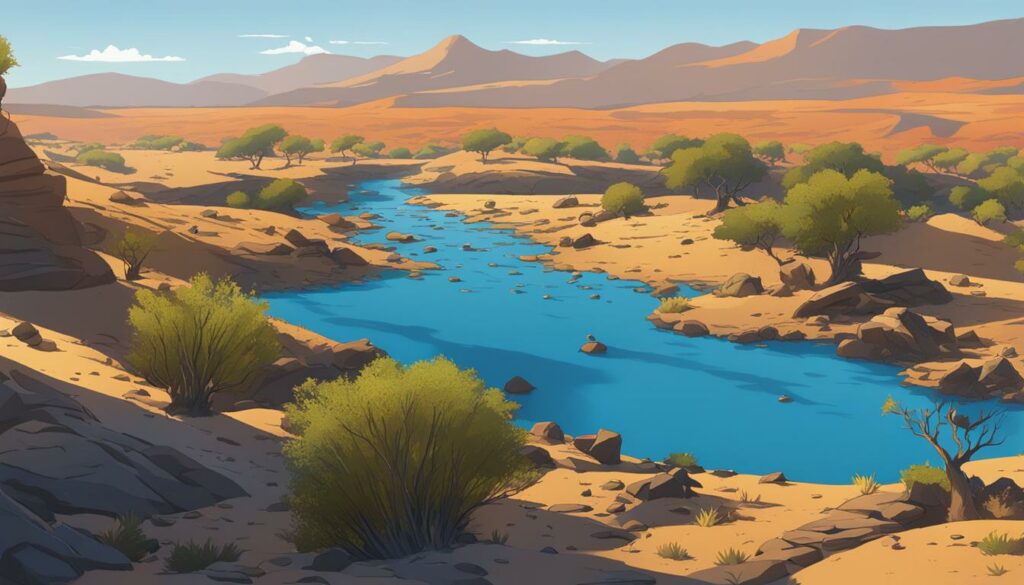
Examples of Chaparral Adaptations
| Chaparral Flora Adaptations | Chaparral Fauna Adaptations |
|---|---|
| Small, waxy leaves to reduce water loss | Efficient kidneys for water conservation |
| Deep root systems for accessing water | Ability to obtain water from food sources |
| Dormancy during dry season to conserve energy | Behavioral adaptations to seek shade |
| Thick bark for protection during wildfires | Physiological adaptations for temperature regulation |
| Rapid regeneration through burls after fires | Ability to live without drinking water |
The Varied Diet Adaptation of Animals in the Chaparral Biome
Animals dwelling in the chaparral biome have developed a unique adaptation to ensure their survival in this challenging environment – a varied diet. The chaparral biome is known for its limited vegetation, with sparse resources available for animal consumption. To overcome this scarcity, animals in the chaparral have evolved to consume a wide range of foods, allowing them to meet their nutritional needs and thrive in this arid ecosystem.
These animals display remarkable adaptations that enable them to find sustenance and survive in a habitat with limited resources. They have become highly opportunistic in their feeding behaviors, taking advantage of the diverse food choices available to them. Whether it’s foraging for fruits, leaves, seeds, or even insects and small animals, these chaparral inhabitants have learned to adapt their diets to the ever-changing availability of food.
This varied diet adaptation in chaparral animals is crucial for their survival. By consuming a diverse range of foods, they can maintain their energy levels, obtain essential nutrients, and adapt to the fluctuations in vegetation and food sources that occur within the chaparral biome.
“The varied diet adaptation of animals in the chaparral biome is a testament to their resilience and adaptability. By embracing a wide range of food sources, these animals have found a way to not just survive, but thrive in this challenging environment.”
The Strategic Foraging of Chaparral Animals
Chaparral animals have developed various strategies to optimize their foraging efforts and ensure they can find enough food to survive. These strategies include:
- Scavenging: Some chaparral animals have become proficient scavengers, relying on consuming the remains of other animals or carrion to supplement their diet.
- Opportunistic Feeding: Chaparral animals take advantage of seasonal changes and the availability of different food sources. They adapt their feeding behaviors to consume the plants, fruits, seeds, or insects that are abundant during specific times of the year.
- Seed Dispersal: Certain chaparral animals play a crucial role in the ecosystem by aiding in seed dispersal. They consume the fruits or seeds of plants and disperse them in new locations, helping with the propagation and survival of plant species within the chaparral biome.
Despite the challenges of limited resources, chaparral animals have found innovative ways to adapt their diets and ensure their survival in this demanding environment.
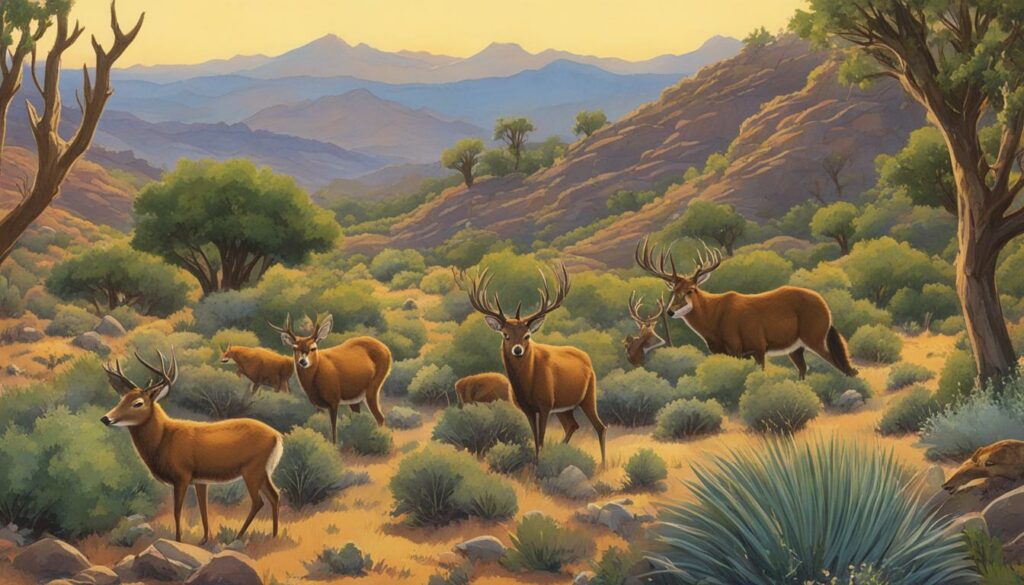
| Animal | Primary Food Sources |
|---|---|
| Coyote | Small mammals, insects, fruits, grasses |
| Roadrunner | Lizards, snakes, rodents, insects, fruits, seeds |
| Bobcat | Rabbits, rodents, birds |
| Gray Fox | Rodents, small mammals, insects, fruits |
The Importance of Adaptation in Chaparral Animals
The ability of chaparral animals to adapt their diets plays a vital role in their survival within this harsh biome. Their flexible feeding behaviors allow them to overcome the limitations imposed by the scarcity of vegetation. This adaptation not only ensures their individual survival but also contributes to the overall ecological balance and biodiversity of the chaparral biome.
By embracing a varied diet, chaparral animals help maintain the delicate equilibrium within this ecosystem. Their feeding habits contribute to seed dispersal, pollination, and nutrient recycling, ultimately shaping the plant communities and supporting the overall health and sustainability of the chaparral biome.
Through their varied diet adaptation, chaparral animals exemplify nature’s remarkable ability to find solutions and thrive even in the most challenging environments.
The Diverse Plant Life in the Chaparral Biome
The chaparral biome is a fascinating ecosystem that hosts a wide range of plant species uniquely adapted to its challenging conditions. These plants have developed various strategies to thrive amidst the arid climate and periodic wildfires, showcasing the remarkable resilience and ingenuity of nature.
One notable adaptation of the plant life in the chaparral biome is the presence of evergreen shrubs and small trees equipped with fire-resistant burls. These burls enable the plants to quickly regenerate after a fire, ensuring their survival and contributing to the overall resilience of the ecosystem.
Let’s take a closer look at some of the diverse plant species found in the chaparral biome:
Chaparral Plant Diversity
In the chaparral biome, you’ll encounter a variety of plant species that have evolved to thrive in this unique environment. Here are a few examples:
| Plant | Adaptations |
|---|---|
| Manzanita | Drought-resistant leaves and bark, fire-resistant burls |
| Chamise | Highly flammable foliage, fire-dependent germination |
| Sagebrush | Deep roots for water absorption, aromatic leaves to deter herbivores |
These are just a few examples of the diverse plant life in the chaparral biome. Each species has unique characteristics and adaptations that allow them to flourish in this challenging environment.
The survival of plants in the chaparral biome is not solely dependent on their individual adaptations, but also on their interactions with other species and the overall ecological balance of the ecosystem. From providing shelter and food for various animal species to contributing to the prevention of soil erosion, the plant life in the chaparral plays a vital role in maintaining the health and functionality of the biome.

Vegetation in the Chaparral Biome
In the chaparral biome, the vegetation plays a crucial role in the overall beauty and functionality of this unique ecosystem. The plants that thrive in the chaparral biome have adapted to the dry and arid conditions, making them well-suited to survive the intense heat and limited rainfall.
Typical chaparral plants include various shrubs that are resilient and hardy. Manzanita is one such shrub that is commonly found in the chaparral biome. It is known for its beautiful bark and vibrant flowers, showcasing the resilience of life in this harsh environment. Another common chaparral shrub is chamise, which has small leathery leaves and clusters of white flowers that add to the charm of the biome. Sagebrush, with its aromatic scent and gray-green foliage, is also a prominent feature of the chaparral vegetation.
The chaparral biome boasts a diverse array of plant species, each with unique adaptations that allow them to thrive in this challenging environment. From evergreen shrubs to flowering plants, the chaparral showcases the resilience and ingenuity of nature.
“The chaparral biome’s vegetation is a testament to nature’s ability to adapt and survive in even the harshest conditions.”
Key Features of Chaparral Vegetation
The vegetation in the chaparral biome possesses several key characteristics that enable it to thrive:
- Drought tolerance: Chaparral plants have evolved to survive in areas with limited water resources. Their roots can reach deep into the ground, allowing them to tap into hidden water sources.
- Fire resistance: Chaparral plants have developed fire-resistant features such as thick bark, fire-resistant burls, or the ability to resprout after a fire, ensuring their survival in a fire-prone environment.
- Adaptation to arid conditions: The leaves of chaparral plants are typically small, leathery, and coated with a waxy layer to reduce water loss through evaporation.
- Diversity: The chaparral biome is home to a wide variety of plant species, each with unique adaptations that contribute to the overall biodiversity of the ecosystem.
Here is an overview of some typical chaparral plants:
| Name | Description | Image |
|---|---|---|
| Manzanita | A shrub with beautiful bark and vibrant flowers. It is known for its ability to regenerate quickly after a fire. | 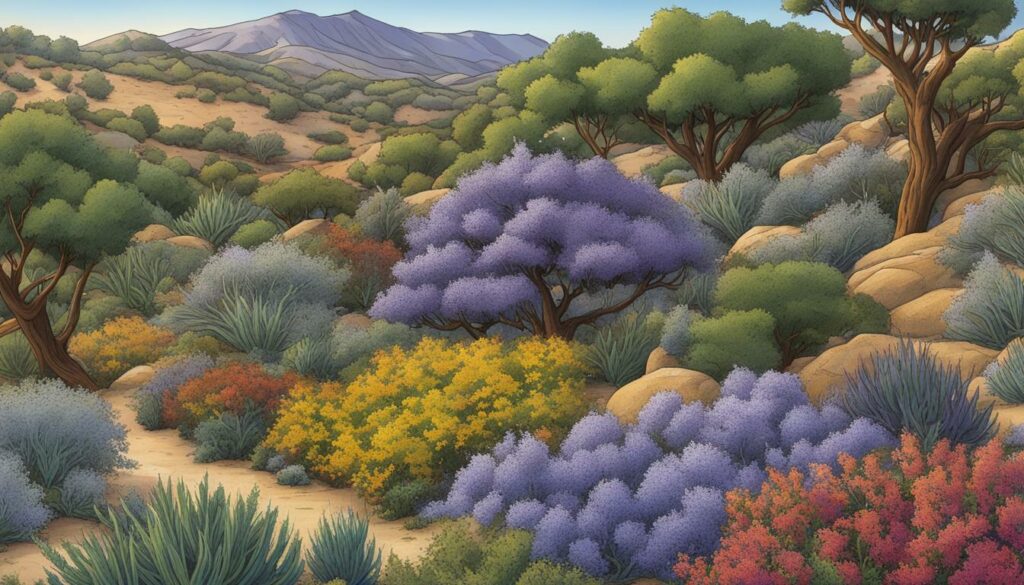 |
| Chamise | A shrub with small leathery leaves and clusters of white flowers. It is fire-adapted and can resprout after a fire. | |
| Sagebrush | A shrub with gray-green foliage and an aromatic scent. It is well-suited to the chaparral’s arid conditions. |
The vegetation in the chaparral biome plays a vital role in sustaining the ecosystem and providing habitat and food for a diverse range of animal species. It is a testament to the remarkable adaptability of nature and the interconnectedness of life.
The Remarkable Animals of the Chaparral Biome
The chaparral biome is teeming with an abundance of fascinating animal species. From the clever coyotes to the agile lizards, these unique creatures have found ingenious ways to adapt and thrive in the challenging conditions of the chaparral.
One of the most captivating features of the chaparral biome is its animal diversity. Coyotes, known for their cunning and adaptability, roam the chaparral, showcasing their remarkable survival skills. These clever canines have evolved to become skilled hunters, capable of preying on a variety of small mammals and reptiles.
Alongside the coyotes, the chaparral is also home to a plethora of lizards, each species displaying unique characteristics and adaptations. From the swift and elusive western fence lizard to the iconic California horned lizard, these reptiles have developed specialized behaviors and physical attributes to withstand the harsh conditions of the chaparral.
Rabbits, with their remarkable agility and ability to reproduce rapidly, are another common sight in the chaparral biome. They possess powerful hind legs that enable them to swiftly evade predators and survive in this demanding environment.
The chaparral also attracts a diverse array of bird species, adding color and melody to the vibrant landscape. From the California quail with its distinctive plume to the majestic golden eagle soaring through the skies, these magnificent winged creatures find refuge in the chaparral’s unique ecosystem.
The remarkable adaptations of the animals in the chaparral biome are a testament to the resilience and resourcefulness of nature. From specialized diets to physical attributes that aid survival, these creatures have carved out a niche for themselves in this challenging environment.
Chaparral Animal Adaptations:
- Camouflage: Many animals in the chaparral have developed colors and patterns that blend seamlessly with their surroundings, allowing them to hide from predators or stalk their prey unnoticed.
- Nocturnal Behavior: Some animals have adapted to become primarily active during the cooler night hours, avoiding the scorching temperatures of the day.
- Drought Tolerance: Many chaparral animals can survive extended periods without water, obtaining moisture from their food or through physiological adaptations that reduce water loss.
- Burrowing: Certain animal species, such as kangaroo rats, have evolved to dig elaborate burrows that serve as shelter from extreme temperatures and predators.
These remarkable adaptations enable the animals of the chaparral biome to navigate and thrive in an ever-changing environment. They are an integral part of the intricate web of life that sustains this mesmerizing ecosystem.
| Animal | Adaptation |
|---|---|
| Coyote | Excellent hunting skills and adaptable diet |
| Western Fence Lizard | Quick reflexes and ability to shed tail to escape predators |
| California Horned Lizard | Camouflage and ability to shoot blood from its eyes as a defense mechanism |
| Rabbit | Powerful hind legs for fast escapes and rapid reproduction |
| California Quail | Distinctive plume and ability to run swiftly to avoid predators |
| Golden Eagle | Impressive wingspan and keen eyesight for hunting |
The remarkable animals of the chaparral biome capture our imagination and remind us of the incredible diversity and adaptability of life on Earth. Their presence in this unique ecosystem is a testament to the delicate balance and fascinating interplay between species and their environment.
The Intersections of the Chaparral Biome with Other Ecosystems
The chaparral biome is a diverse and vibrant ecosystem that intersects with other arid biomes, including deserts. This intersection creates a dynamic environment where different ecosystems come together, fostering unique relationships and interactions among plants and animals.
In the chaparral biome, the relationships between different biomes play a crucial role in maintaining biodiversity and ecological balance. The interactions between the chaparral and other ecosystems are essential for the health and survival of the various plant and animal species that call the chaparral home.
The chaparral biome’s intersection with deserts, in particular, offers fascinating insights into the natural world. These two ecosystems share similarities in terms of aridity and a scarcity of water resources. However, they also have distinct characteristics that contribute to their unique biodiversity and plant adaptations.
When the chaparral biome intersects with deserts, it creates an environment of complexity and contrast. The chaparral’s moderate climate, with its intermittent rainfall and mild summers, provides a stark contrast to the extreme heat and aridity of the desert. This contrast allows for the coexistence of diverse plant and animal species that have adapted to thrive in these contrasting environments.
Plant species in the chaparral biome have developed remarkable adaptations to survive in arid conditions. They possess features like small leaves, waxy coatings, and deep root systems to minimize water loss and maximize water absorption. In contrast, desert plants have evolved unique strategies, such as succulence, water storage, and reduced leaf surfaces to conserve water and tolerate extreme heat.
Similarly, animal species in the chaparral biome and deserts have distinct adaptations that enable them to survive in their respective environments. For example, in the chaparral biome, animals like coyotes have adapted to become proficient scavengers, utilizing fruits, insects, and small mammals as their food sources. Desert animals, such as camels, have evolved specialized physiological mechanisms to conserve water and tolerate extreme temperatures.
The intersections of the chaparral biome with other ecosystems provide rich opportunities for studying the intricate relationships between various biomes and understanding the adaptations of plants and animals. By delving into these intersections, researchers can gain valuable insights into biodiversity, ecological resilience, and the interconnectedness of ecosystems.
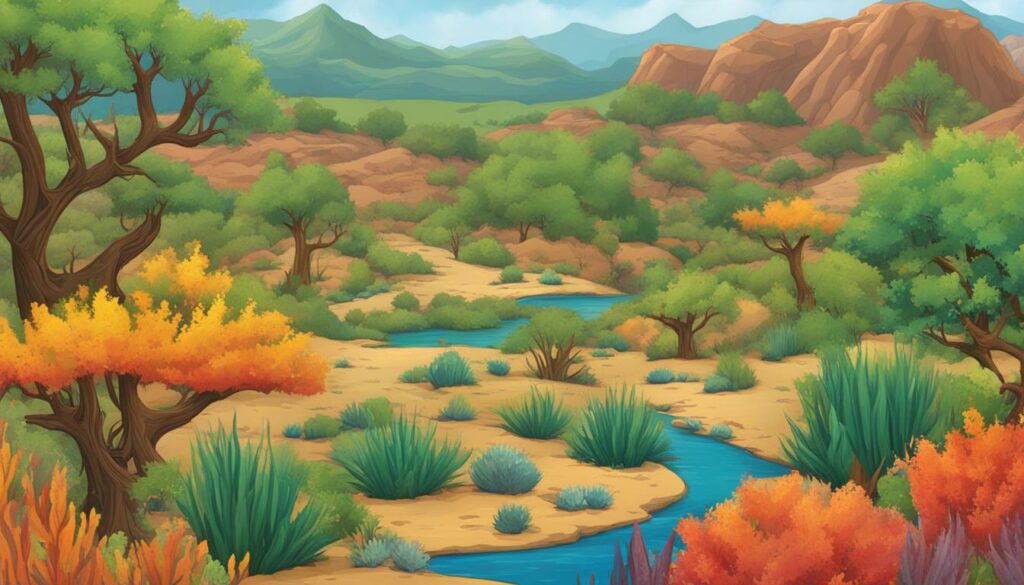
Conclusion
The chaparral biome is a remarkable ecosystem that offers a wide range of uses and benefits. The diverse plant and animal life found in this unique habitat showcase the ingenuity and resilience of nature. From the fire-resistant burls of the vegetation to the varied diet adaptations of the animals, the chaparral has evolved to thrive in its challenging environment.
However, the significance of the chaparral biome extends beyond its ecological attributes. This ecosystem holds cultural connections and historical tales, such as the iconic cowboy chaps named after the chaparral itself, and the presence of the now-extinct California Grizzly Bear. These connections remind us of the influence nature has on culture and the importance of preserving biodiversity.
By understanding and appreciating the beauty and functionality of the chaparral biome, we can develop a deeper appreciation for the delicate interconnectedness of our planet’s ecosystems. It is our responsibility to protect and conserve this captivating biome, ensuring its secrets continue to be uncovered for generations to come.
FAQ
What are some common uses of chaparral?
Chaparral has various uses, including its medicinal properties for treating sexually transmitted diseases, infections, pain relief, arthritis, and colds. It can also be used in herbal remedies for overall health support.
What are the benefits of chaparral?
Chaparral offers numerous benefits due to its antimicrobial, anti-cancer, anti-inflammatory, antibacterial, and anti-tumor properties. It is particularly effective in addressing sexually transmitted diseases and infections, as well as providing pain relief, anti-arthritis, and cold-fighting properties.
Are there other ingredients that can be combined with chaparral for herbal remedies?
Yes, other ingredients such as sarsaparilla, black seed, burdock root, bladderwrack, and sea kelp can be combined with chaparral to create powerful herbal blends that support overall health.
Are chaparral herbal remedies made from organic herbs?
Yes, chaparral herbal remedies are made from organic herbs and contain no fillers, ensuring high quality and effectiveness.
Who inspired the creation of these herbal remedies?
These herbal remedies have been inspired by the renowned herbalist Dr. Sebi.
Source Links
- https://www.tiktok.com/discover/Chaparral-leaf-benefit
- https://www.lolaapp.com/interesting-facts-about-the-chaparral-biome/

